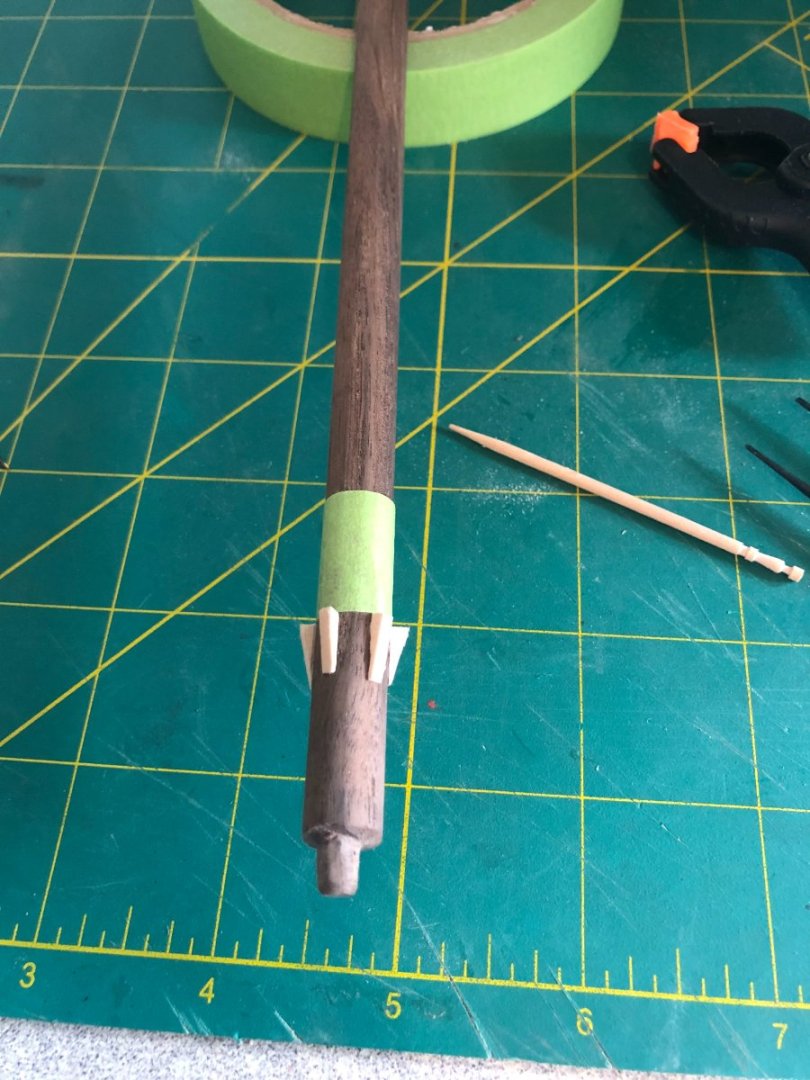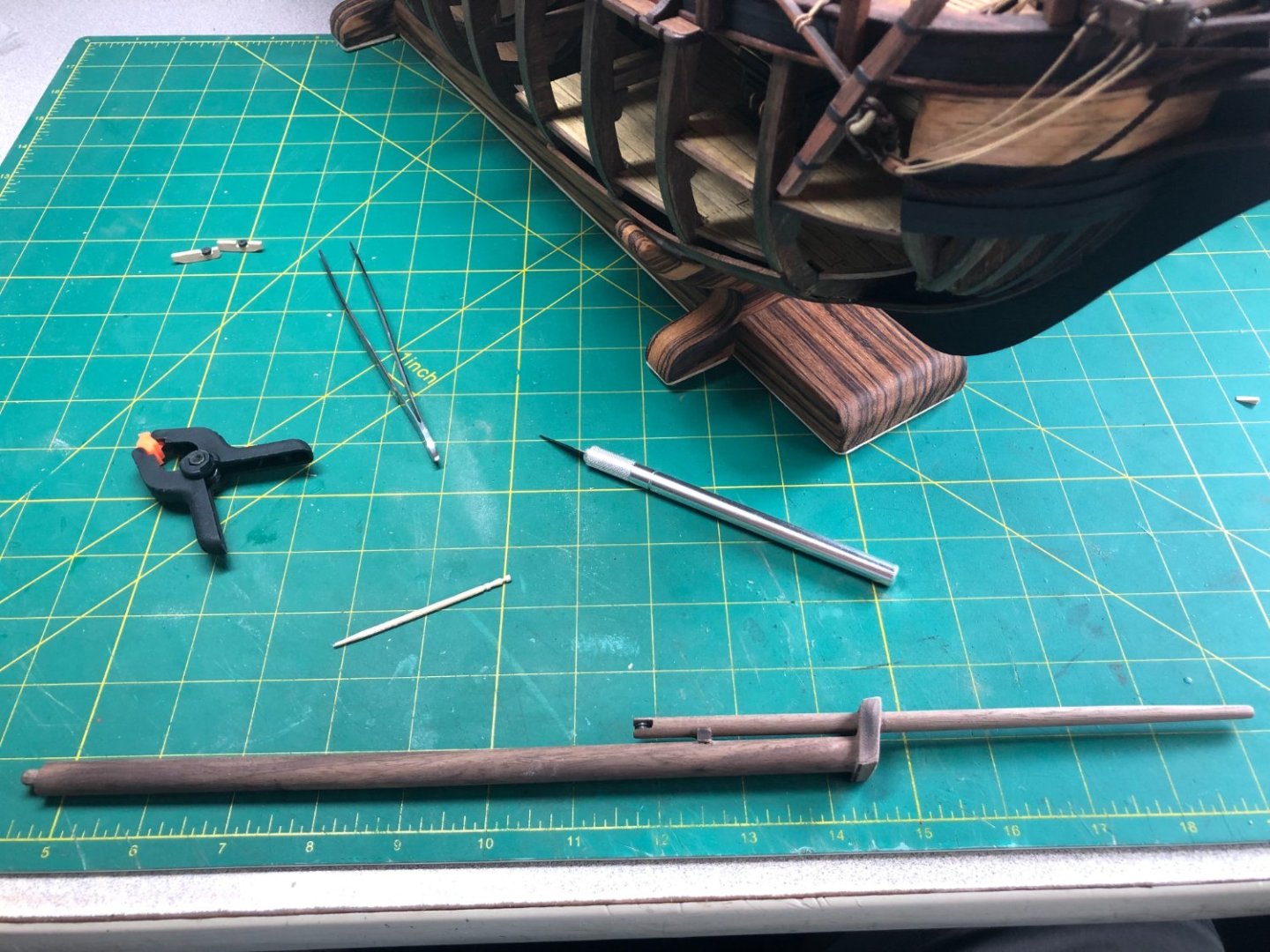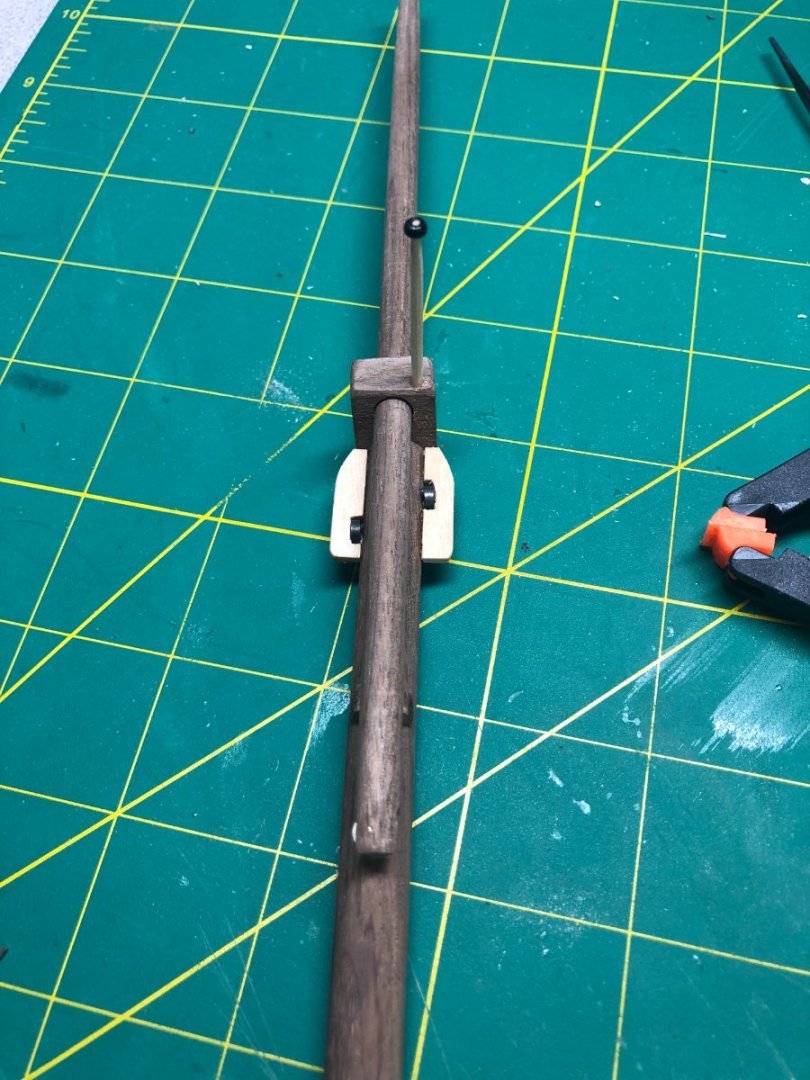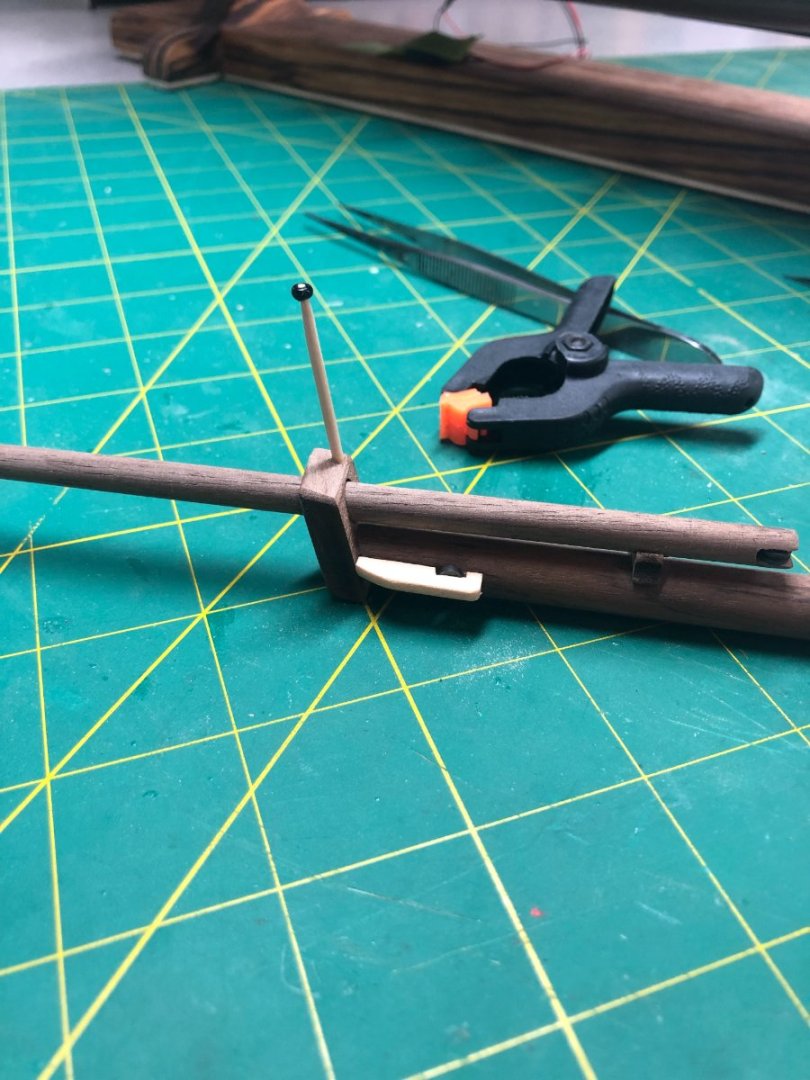-
Posts
538 -
Joined
-
Last visited
Content Type
Profiles
Forums
Gallery
Events
Everything posted by LyleK1
-
Lots of pictures going forward on the masting and rigging. I've looked at numerous sources for the little details that are just not well pictured or explained. So, going forward, I will attempt to make it bit easier on the next builder! I went back and reattached the anchor rodes in the mid-bilge area: Figured it would be easier to do now when the masts are not on the boat! The rigging attached to the bowsprit was very hard to follow but I am confident I got most of (if not all) it right. As mentioned nothing gets done until I've researched it first unless it's REAL obvious! The next series of pictures is that rigging being incrementally installed: The Traveler was an item that took me a ton of time to figure out! Again, based on several sources, here is my rendition: A tad out of round! But trust me, that was my best one! That was really tough to make and harder to find a decent picture of one! And finally, the completed bowsprit from several angles and close-ups: On to the spritsail yard.
-
Thanks Trond. The book is only accurate to a point. The author points out that little is known about the figurehead. I used a little artistic freedom based on historical accounts of many vessels from that time period. The rigging in the book is difficult (at best) to follow from end to end on many of the lines... but still is a point of reference too.
-
Ok... The rigging plans, drawings and instructions ARE NOT VERY GOOD! I have to spend a ton of time reading other logs, looking at the two books (Lee's and Petersens's), researching on the internet, etc. before I even start doing the actual work. I suspect that I will need to research just about every standing line and running line which does have advantages... By the time I'm done, I should have a better than working knowledge of the entire rigging system. We' see! I started with the "Woman in a Riding Habit" figurehead since it is directly below the bowsprit. Good thing I did too. The stem required some alterations to make her fit. Nothing drastic and I used a round file to do most of the work. Additionally, I painted her: I did quite a bit of research on figureheads and decide to leave her bare chested... here's an excerpt from one of my sources: "...such figures, baring one or both breasts, had been popular in both merchant and naval ships. Sailors' superstitions viewed women on board a ship as unlucky but a semi-naked sculpted female form was believed to calm storms at sea." I don't think it worked too well for Bligh! After painting, I gave it a "wash" to give it some highlights and once dry, mounted it: My painting skills look better from a better distance!! The bowsprit and jib had to be altered some to accommodate mounting and the jib was tapered per the drawings and then joined together using the saddle piece between them: I also added the sheave at the aft end of the jib. I should add that getting the angle of the bowsprit and jib boom was a lot of work with a file. The block as two round holes (one should be square but I left it) These holes required a lot of round file work. The Bees of the bowsprit were shaped and the sheaves added: And then installed on the bowsprit: The cleats were all hand cut and then installed. I used tape to mark the position of a row of cleats and then just glued them on: Also added the Jack Staff... I use a black bead for the tip... which I later changed to a wood knob (it will be in the last few pictures). And lastly, painted: You'll notice, I added 3 rings on the starboard side... The plans don't show any on the port side, not sure if that's accurate but they are relatively easy to add later, if needed. I've spent considerable time researching the "Traveler" and how to make it and have begun attaching the standing and running rigging blocks but as I noted above, I have to research each line to understand how it is attached to the bowsprit or jib boom and what its purpose. Back in a few days with the finished bowsprit!
-
Just got caught up on your progress... some very impressive work. Especially the ship's wheel! Your kit seems to rival mine in the lack of instructions, material and drawings. The AL instructions are non-existent once the main deck is done. The masting and rigging is all drawings... not great ones! I'm enjoying your log.
-
Just a quick update... I'm between boat trips with the big one coming in less than a month! I worked on rope hanks and rope coils. If you're interested in the details of products used and the process, check out this link: Rope hanks installed (temporarily on the belaying pin), I'll do a couple more smaller ones for the anchor tie-downs and will then mass produce a bunch for later use! Rope coils made too: Starting making measurements on the bowsprit and immediately found a pretty large difference between the parts listing and the drawings... a difference of 10mm in two cases. WIll ask for some help and do some checking with other plans. More when I can!
-
So, as I posted above I decided to try clear shellac and Liquitex Matte Medium. I made a jig to help with making the rope hanks... some trial and error to get the size(s) that I wanted: As can be seen, on the left is the hank made using clear shellac and on the right is the Liquitex. After making the necessary winds on each hank, I dabbed the tops and bottoms of the loops with the product nearest to it. The first time, I did not allow it to dry enough and had to restart. On the second attempt, I let both dry several hours. However, after about an hour, I did return and twisted the nails to keep the hanks from sticking. I also have packing tape on the wood to prevent adhesion: After a few hours, I used an Exacto-knife to remove loops: The hank with the shellac was very fragile and came apart too easily. Both attempts yielded the same results. However, the hanks maybe a bit more realistic looking... more on that in a bit. The hank pictured above is assembled with the Liquitex. The Liquitex consistently did a better job of adhering the rope. But it does have issues too. The biggest issue is the residue it left. Look closely at the next photo: The residue may be solved by either, using less product or possibly, diluting it just a bit. As I do more hanks, I'll try to refine my process. For me, the Liquitex is the better choice but... I still want to try the shellac on knots! Here's a couple photos of my first few completed and temporarily placed: Liquitex version above Shellac version - I think it looks a little more realistic. The Liquitex are almost too close to perfect. Liquitex version I also produced one rope coil (loosely rolled) using the Liquitex: Although certainly not conclusive, for me, I have my answer and will use the Liquitex for the hanks and coils. The jury is still out on the shellac for knots, etc. I'll update the group when I have a chance to try it. It might be a bit as I am headed out on a boat trip soon... be back in the late summer or early fall!
-
Well done, Dave! My results are in the next post!
-
You cannot store it in a squeeze bottle... it evaporates very fast. You can buy it in smaller quantities but still have to open the can!
-
Maybe my solution was diluted too much? My coils just came apart and the served line unraveled completely. I soak both and let them dry overnight too.
-
Another option to try... I've already purchased the other two products. If they are not up to standards, I'll try this one next. Thanks for the tip Dee-Dee.
-
With the exception of the stern lanterns and a few rope hanks (more on this later in the post), the deck work is done! The last few steps took a little longer than I anticipated... shocking, I know! The ship's bell was a challenging assembly. Bending the brass wire wasn't too bad but soldering the hook to the wire took some practice as I hadn't soldered in quite some time. In the end, I got it looking decent and then did some blackening to give it that aged look: The half-pounder cannons were equally challenging as the assembly really wasn't thought out very well by the kit manufacturer (IMHO). First, after doing some research, I could not find a single image of a cannon that was bent at about a 75 degree angle... all of them were straight, front to back. Based on that, I did not bend mine. Second, the brass wire used to hold the cannon to the bracket was so small that it would just slide out... more soldering! I soldered the wire to the brackets and blackened the entire assembly before installing them: The bell installed: The cannons installed: Rope coils, hanks and served lines were a bigger problem than I thought. As I've mentioned, I make my own rope and I use a poly material rather than cotton. Poly has a longer life and does not have that annoying "fuzz". What I didn't know is that diluted PVA IS NOT a good adhesive to use on poly rope! I have another thread in the masting and rigging section about this problem and got some good help from the more knowledgeable members. After reading through their comments and suggestions, I have decided to try 3 different methods to solve the problem. 1. Use clear shellac 2. Use Liquitex Matte Medium 3. Use Downy fabric softener (this for the hanks only) Once, I have completed my experiments, I'll report back here and on the previously mentioned thread. In the meantime, I did do a couple of loose coils for the Launch using diluted PVA (which was a struggle and began my search for another method): The next update may be a bit as our first long boat trip starts later in the week. We'll talk again when I have more to report.
-
Thanks Bob! Clearly and concisely answered any questions I had... I've decided to get some clear shellac and Liquitex Matte Medium to experiment with on my ropes. Once I have both one hand, I'll try out a few different coils, hanks and served lines. I'll report back here on my findings and conclusions.
-
I have not… Leaning toward trying clear shellac. But not opposed to trying the lacquer too. The “Downy” method is intriguing too… but need more info on it.
About us
Modelshipworld - Advancing Ship Modeling through Research
SSL Secured
Your security is important for us so this Website is SSL-Secured
NRG Mailing Address
Nautical Research Guild
237 South Lincoln Street
Westmont IL, 60559-1917
Model Ship World ® and the MSW logo are Registered Trademarks, and belong to the Nautical Research Guild (United States Patent and Trademark Office: No. 6,929,264 & No. 6,929,274, registered Dec. 20, 2022)
Helpful Links
About the NRG
If you enjoy building ship models that are historically accurate as well as beautiful, then The Nautical Research Guild (NRG) is just right for you.
The Guild is a non-profit educational organization whose mission is to “Advance Ship Modeling Through Research”. We provide support to our members in their efforts to raise the quality of their model ships.
The Nautical Research Guild has published our world-renowned quarterly magazine, The Nautical Research Journal, since 1955. The pages of the Journal are full of articles by accomplished ship modelers who show you how they create those exquisite details on their models, and by maritime historians who show you the correct details to build. The Journal is available in both print and digital editions. Go to the NRG web site (www.thenrg.org) to download a complimentary digital copy of the Journal. The NRG also publishes plan sets, books and compilations of back issues of the Journal and the former Ships in Scale and Model Ship Builder magazines.







